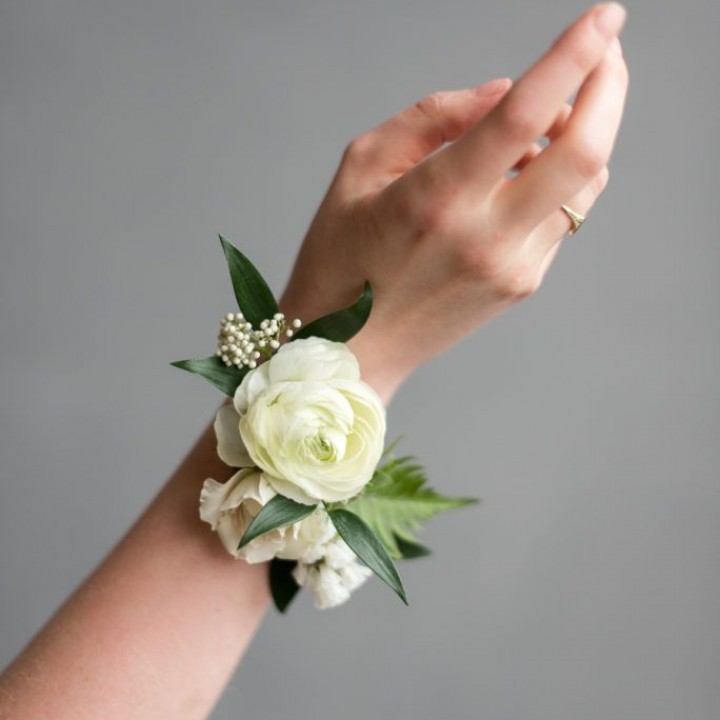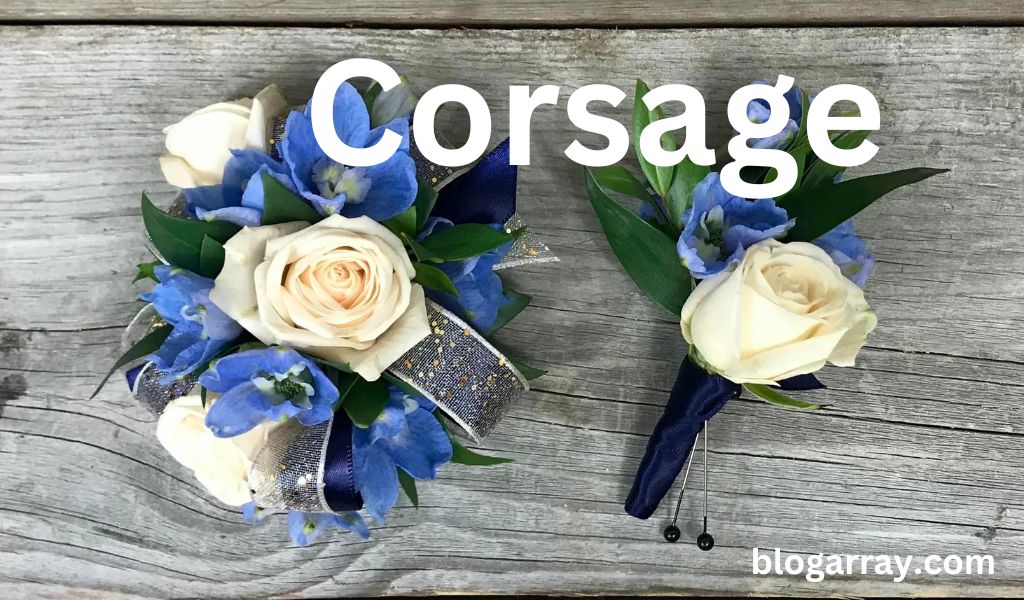The Ultimate Guide to Choosing the Perfect Corsage for Every Occasion
When it comes to accessorizing for formal events, the corsage stands out as a timeless piece that adds a touch of elegance and personalization to any outfit. Whether you’re attending a wedding, prom, or another special event, a corsage can be the perfect floral accessory to complete your look. This guide will delve into everything you need to know about corsages—from their history and symbolism to modern-day styles and how to perfectly pair them with a boutonniere.
Corsage: A Brief History
Corsages have been worn for centuries, with their origins tracing back to ancient Greece. The term “corsage” is derived from the French word for “bodice,” as these floral arrangements were originally pinned to the bodices of women’s dresses. Historically, corsages were believed to ward off evil spirits, protect against illness, and bring good luck.
As fashion evolved, so did the placement and style of corsages. By the 20th century, the tradition of wearing corsages at formal events like weddings and proms became more prominent. Today, corsages are a symbol of love, honor, and respect, often gifted by a significant other or a close family member.
Types of Corsages
Corsages come in various styles and can be customized to match the occasion, outfit, and personal preference. Here are some popular types of corsages:
Wrist Corsage
The wrist corsage is the most common style seen at proms and weddings. It consists of a small floral arrangement attached to an elastic band or bracelet that is worn on the wrist. The convenience and comfort of wrist corsages make them a popular choice, as they do not damage clothing and allow for easy movement.
Pin-On Corsage
Pin-on corsages are traditional and are often seen at weddings and formal gatherings. This type of corsage is pinned to the left side of a dress or suit jacket. Pin-on corsages are versatile and can be adjusted to different areas of the outfit, making them a flexible option for various styles.
Shoulder Corsage
A shoulder corsage is a larger floral arrangement that is typically worn on the shoulder of a gown or dress. This style is less common but can be a statement piece for bridesmaids or mothers of the bride and groom. Shoulder corsages are elegant and add a touch of drama to formal attire.
Hand-Held Corsage
Also known as a “bouquet corsage,” the hand-held corsage is a small floral bouquet carried by the individual. This style is perfect for those who prefer not to wear flowers directly on their clothing. Hand-held corsages are often used in weddings, where they can complement the bride’s bouquet.
How to Choose the Perfect Corsage
Selecting the right corsage involves considering the event, outfit, and personal preferences. Here are some tips to help you make the best choice:
Match the Occasion
The type of event will greatly influence your choice of corsage. For a wedding, a more elegant and classic design may be appropriate, while for a prom or graduation, something more playful and colorful might be suitable.
Coordinate with the Outfit
The corsage should complement the colors and style of the outfit. For instance, if you’re wearing a dress with a lot of patterns, a simpler corsage might be best. On the other hand, a plain dress can be enhanced with a more elaborate corsage.
Consider the Season
The flowers used in the corsage should reflect the season of the event. Spring and summer corsages can feature bright, vibrant blooms, while autumn and winter corsages might include deeper, richer colors and seasonal foliage.
Personal Preference
Personal style plays a significant role in choosing a corsage. Whether you prefer something traditional or modern, understated or bold, there’s a corsage style to match your taste.
Popular Flowers Used in Corsages
The choice of flowers is essential in creating a beautiful and meaningful corsage. Here are some popular options:
Roses
Roses are a classic choice for corsages, symbolizing love and elegance. They come in a variety of colors, each with its own meaning, making them a versatile option.
Orchids
Orchids represent beauty and strength. Their exotic appearance makes them a popular choice for more formal or luxurious events.
Carnations
Carnations are affordable and durable, making them a practical choice for corsages. They are available in many colors and can be easily dyed to match specific outfits.
Baby’s Breath
Often used as a filler, baby’s breath adds a delicate, airy touch to corsages. Its small white blooms are perfect for complementing more prominent flowers.
Lilies
Lilies are bold and fragrant, making them an excellent choice for statement corsages. Their large blooms add a touch of drama and sophistication.
Corsage and Boutonniere: The Perfect Pair
A corsage and boutonniere are often seen together, especially at weddings and proms. While the corsage is worn by women, the boutonniere is typically worn by men on the lapel of a suit or tuxedo. Here’s how to ensure your corsage and boutonniere are perfectly paired:
Color Coordination
The flowers in the corsage and boutonniere should be coordinated in terms of color. This doesn’t necessarily mean they have to be identical, but they should complement each other. For instance, if the corsage features blush pink roses, the boutonniere might include a single blush pink rosebud with matching greenery.
Style and Size Matching
While the corsage can be more elaborate, the boutonniere should be simpler and more understated. However, both should reflect a similar style. If the corsage is traditional, the boutonniere should follow suit. Conversely, if the corsage is more modern or whimsical, the boutonniere should match that theme.
Floral Harmony
Using the same type of flowers in both the corsage and boutonniere creates a harmonious look. This unity in floral choices ties together the overall aesthetic of the couple’s attire.
DIY Corsage: A Step-by-Step Guide
Creating your own corsage can be a fun and rewarding experience. Here’s a simple guide to making a wrist corsage:
Materials Needed
- Fresh flowers (roses, orchids, or your choice)
- Floral tape
- Scissors
- Ribbon
- Elastic wristband or bracelet
- Floral wire
- Greenery (optional)
Step 1: Prepare the Flowers
Start by selecting your flowers. Trim the stems to about 2-3 inches long and remove any leaves or thorns. For delicate flowers, wire the stems to provide support.
Step 2: Arrange the Flowers
Decide on the arrangement of your flowers. Place the larger flowers in the center, with smaller blooms and greenery around the edges. Play around with the positioning until you’re satisfied with the look.
Step 3: Secure with Floral Tape
Once your flowers are arranged, use floral tape to secure the stems together. Wrap the tape tightly around the stems to ensure they stay in place.
Step 4: Attach to the Wristband
Attach the taped flower arrangement to the wristband or bracelet using floral wire. Make sure it’s secure but not too tight to wear comfortably.
Step 5: Add the Ribbon
For an added touch of elegance, tie a ribbon around the base of the flowers, covering the floral tape and wire. This will also help secure the arrangement to the wristband.
Step 6: Final Adjustments
Make any final adjustments to your corsage, ensuring all flowers are securely in place and the arrangement looks balanced.

How to Properly Wear a Corsage
Wearing a corsage correctly is crucial to ensure it looks its best throughout the event. Here are some tips:
Wrist Corsage
Place the wrist corsage on the non-dominant hand, so it doesn’t interfere with activities such as eating or greeting people. Ensure the flowers face outward, away from the body, for the best visual effect.
Pin-On Corsage
For pin-on corsages, position the corsage on the left side of the chest, slightly below the shoulder. Use a straight pin to secure it in place, making sure it’s not too tight to avoid damaging the fabric.
Shoulder Corsage
Shoulder corsages should be placed on the shoulder area, with the flowers pointing upwards towards the face. Secure it with multiple pins to prevent it from shifting during the event.
Corsage Etiquette
Understanding the etiquette surrounding corsages can help avoid awkward situations and ensure everyone is on the same page.
Who Buys the Corsage?
Traditionally, a corsage is given as a gift by a male date to his female companion for events like proms or weddings. However, in modern times, it’s not uncommon for individuals to purchase their own corsage if they are attending the event alone or if it’s more convenient.
When to Present the Corsage
The corsage should be presented just before the event starts, ideally when the couple first meets up. This allows time for any necessary adjustments and ensures the corsage looks fresh throughout the evening.
Matching the Corsage and Outfit
It’s polite to discuss color and style preferences with the recipient beforehand to ensure the corsage matches their outfit. This can prevent any mismatched colors or styles that might clash with the overall look.
Caring for Your Corsage
Corsages are delicate and require proper care to maintain their freshness throughout the event. Here’s how to keep your corsage looking beautiful:
Keep It Cool
Store the corsage in a cool, dry place before the event. If possible, keep it in the refrigerator to preserve the flowers. Just make sure to avoid placing it near fruits, as they can emit gases that cause flowers to wilt.
Avoid Excessive Handling
Try not to handle the corsage too much before wearing it, as this can bruise the flowers and reduce their lifespan. When transporting the corsage, keep it in its box to protect it from damage.
Hydrate the Flowers
If you’re preparing the corsage in advance, lightly mist the flowers with water to keep them hydrated. This is especially important for flowers that are prone to drying out, such as roses or orchids.
Corsage Alternatives
While corsages are a traditional choice, there are alternative floral accessories that can be just as beautiful and appropriate for formal events:
Floral Hairpieces
A floral hairpiece is a great alternative to a corsage, adding a touch of nature directly to your hairstyle. These can range from delicate flower crowns to single blooms pinned into an updo.
Floral Jewelry
Floral jewelry, such as rings, necklaces, or earrings made with real flowers, can be a unique and stylish option. These pieces are often custom-made to match the outfit and event.
Floral Sashes
A floral sash worn around the waist or across the shoulder can be a striking alternative to a traditional corsage. This option is particularly popular in outdoor or garden weddings.
Bouquet
For those who prefer not to wear flowers, carrying a small bouquet can be a wonderful alternative. It allows for more flexibility in flower choices and arrangements.
Conclusion
Corsages are more than just a floral accessory; they are a tradition that adds beauty and meaning to formal events. Whether you choose a wrist corsage, a pin-on corsage, or even a more modern floral alternative, understanding the history, styles, and etiquette of corsages ensures you make the perfect choice for any occasion. Pairing your corsage with a matching boutonniere not only completes the look but also ties the couple’s outfits together beautifully.
Also Read: In Glock We Trust Shirt: A Stylish Statement
FAQs
What is the difference between a corsage and a boutonniere?
A corsage is a small floral arrangement typically worn by women on the wrist or pinned to the dress, while a boutonniere is a single flower or small cluster worn by men on the lapel of a jacket.
Can I make my own corsage?
Yes, making your own corsage is a great way to personalize the accessory and can be done with basic materials like floral tape, wire, and fresh flowers.
How long will a corsage last?
A properly cared-for corsage can last for several hours during an event. To maximize its freshness, store it in a cool place and avoid handling it excessively.
Should the corsage match the dress?
While it’s not mandatory, it’s generally recommended that the corsage complement the dress in terms of color and style to create a cohesive look.
Can men wear corsages?
While it’s less common, men can wear corsages, especially in cultures where this is traditional. However, most men opt for boutonnieres instead.
What flowers are best for a corsage?
Popular flowers for corsages include roses, orchids, and carnations, as they are durable and come in a variety of colors to match any outfit.












